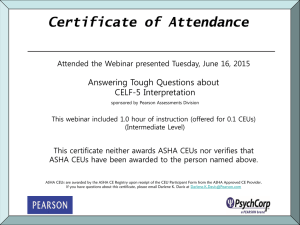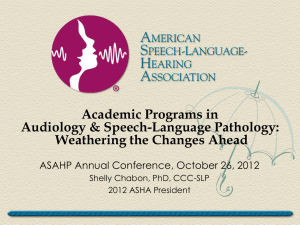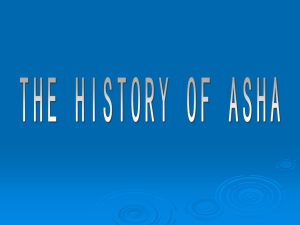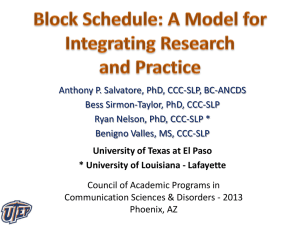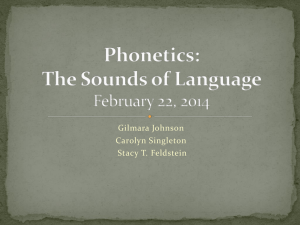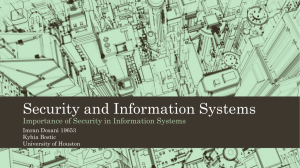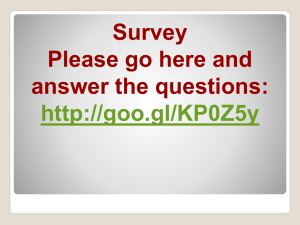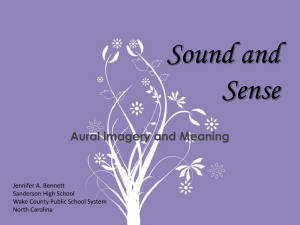A Preschool Teacher`s Guide to Speech and Language Development
advertisement
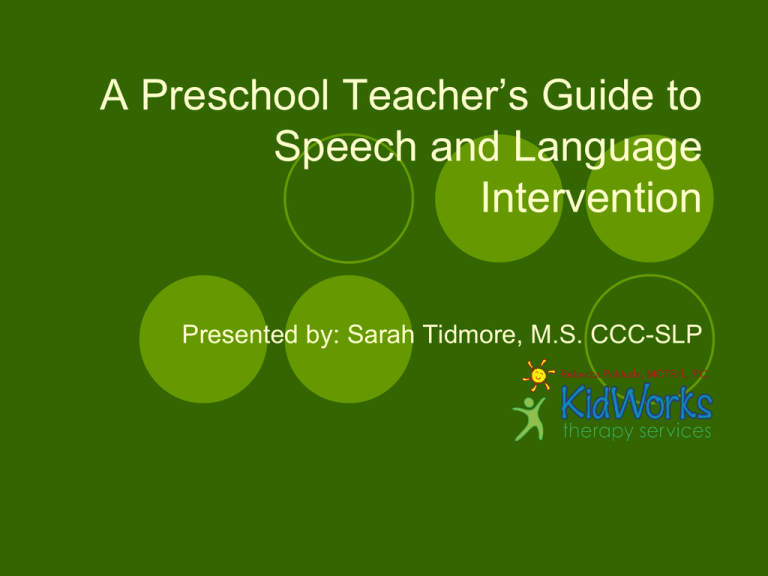
A Preschool Teacher’s Guide to
Speech and Language
Intervention
Presented by: Sarah Tidmore, M.S. CCC-SLP
What is Speech Language Pathology:
A health profession that evaluates,
diagnoses, and treats speech, language,
cognitive-communication, and swallowing
disorders.
Language VS. Speech
Language is made up of socially shared rules that
include:
What words mean
How to make new words
How to put words together
What word combinations are best in what situations
Speech: The actual act of producing the sounds
http://www.asha.org/public/speech/development/language_speech.htm
Language is made up of socially shared
rules
3 Subtypes of Language:
Receptive Language- How the child
understands and processes what is being said
to them.
Expressive Language- How the child shares
thoughts, ideas, and feelings using speech.
Pragmatics- The social and emotional use of
language
http://www.asha.org/public/speech/development/language_speech.htm
Speech: The actual act of producing the
sounds
Components of Speech include:
Articulation: the movement of the lip, tongue, and jaw to produce the
sounds of speech
Intelligibility: The percentage that you are able to understand what the
child is saying
Dysfluency (Stuttering): The many forms of interruptions in the production
of speech that prevent easy, effortless, and smooth flow of speech.
Voice: The use of vocal folds and breathing to create sounds
Oral Motor: How the child uses oral strength and coordination to produce
adequate articulatory precision, and swallow safely and efficiently.
http://www.asha.org/public/speech/development/language_speech.htm
Speech and Language Milestones
Adapted from the American SpeechLanguage - Hearing Association’s
How Does Your Child Hear and Talk?
(http://www.asha.org/public/speech/development/chart.htm)
Birth to 3 months
Receptive Language:
Expressive Language:
Startles at loud sounds
Makes pleasure sounds (cooing
and gooing)
Quiets or smiles when spoken to
Seems to recognize familiar
voices and quiets if crying
Cries differently for different needs
Smile when he/she sees you
Increases or decreases sucking
behavior in response to sound
Shared attention with another
person
http://www.asha.org/public/speech/development/chart.htm
4-6 months:
Receptive Language
Expressive Language
Moves eyes in direction of sounds
Babbling sounds more speech-like
with many different sounds
including /p/,/b/,/m/
Responds to changes in tone of
your voice
Notices toys that make sounds
Chuckles and laughs
Pays attention to music
Vocalizes excitement and
displeasure
Emerging two-way engagement
(peek-a-boo)
Makes gurgling sounds when left
alone and when playing with you
Responds to name
http://www.asha.org/public/speech/development/chart.htm
7 months to 1 year:
Receptive Language
Expressive Language
Enjoys games like pat-a-cake
Babbling both long and short
groups of sounds ex: "tata upup
bibibibi“
Turns and looks in direction of
sounds
Listens when spoken to
Uses speech/non-crying sounds to
get/keep attention
Recognizes words for common
items like "cup", "shoe", "book", or
"juice“
Uses gestures to communicate
(waving, holding arms to be
picked up)
Begins to respond to requests
(e.g. "Come here" or "Want
more?")
Imitates different speech sounds
Has one or two words (hi, dog,
mama) around first birthday.
http://www.asha.org/public/speech/development/chart.htm
What can I do to help? Birth to 1 year
Check the child's ability to hear. Pay attention to ear problems and
reoccurring infections.
Reinforce the baby's communication by making meaningful eye
contact, and imitating vocalizations.
Repeat/Imitate laughter and facial expressions.
Teach the baby to imitate actions, such as peek-a-boo, pat-a-cake,
or waving bye-bye.
Talk while you are doing things ex: dressing or feeding
Talk about where you are going, what you are doing, and who or
what you'll see.
Talk about colors, practice counting, teach animal sounds
http://www.asha.org/public/speech/development/chart.htm
1 to 2 Years
Receptive Language:
Expressive Language:
Points to a few body parts when
asked.
Says more words every month.
Follows simple commands and
understands simple questions
("Roll the ball," "Kiss the baby,"
"Where's your shoe?").
Listens to simple stories, songs,
and rhymes.
Points to pictures in a book when
named.
Uses some one- or two- word
questions ("Where kitty?" "Go byebye?" "What's that?").
Puts two words together ("more
cookie," "no juice," "mommy
book").
Uses many different consonant
sounds at the beginning of words.
At 19-24 months should be 2550% intelligible
Participates in back and forth two
way engagement and
communication.
http://www.asha.org/public/speech/development/chart.htm
What can I do to help? 1-2 years
Talk while doing things/going places. Point to familiar objects and
say their names.
Use simple but grammatical speech that is easy for the child to
imitate. Ex: More cookie
Remember OWL:
Observe what the child is interested in
Wait 10-15 seconds for the child to initiate
Listen to what the child has to say
Expand on words.
Read to the child everyday, talking about the pictures on each page
Have the child point to and/or name pictures and objects.
http://www.asha.org/public/speech/development/chart.htm
2-3 Years
Receptive Language:
Understands opposites ("gostop)
Follows two requests ("Get the
book and put it on the table").
Listens to and enjoys hearing
stories for longer periods of
time
Expressive Language:
Has a word for almost everything.
Uses two- or three- words to talk
about and ask for things.
Uses /k/, /g/, /f/, /t/, /d/, and /n/
sounds.
Speech is understood by familiar
listeners most of the time.
Asks for/directs attention to
objects by naming them.
Speech is 50-75% intelligible
http://www.asha.org/public/speech/development/chart.htm
What can I do to help? 2-3 years
Use clear, simple speech that is easy to imitate.
Show interest, repeat what the child has said and expand on it.
Ask the child to repeat things that you do not understand and model
correct production.
Expand on the child's vocabulary by reading books with simple
sentences.
Name objects and describe the pictures in books, stating synonyms for
familiar words.
http://www.asha.org/public/speech/development/chart.htm
What can I do to help? 2-3 years (cont.)
Make a scrapbook to practice naming pictures, use gestures and
speech to teach object function.
Look at family photos and name the people. Write simple
phrases/sentences to describe what is happening in the pictures.
Ask the child questions that require a choice, rather than simply a
"yes" or "no" answer. Ex: Do you want milk or juice?
Continue to sing songs, play finger games to introduce the child to
the rhythm and sounds of language.
Help the child group objects into categories.
http://www.asha.org/public/speech/development/chart.htm
3-4 years
Receptive Language:
Expressive Language:
Hears you when you call from
another room.
Talks about activities at school or
at friends' homes.
Hears television or radio at the
same loudness level as other
family members.
Unfamiliar listeners understand
child's speech.
Answers simple "who?", "what?",
"where?", and "why?" questions.
Uses sentences with 4 or more
words often.
Talks easily without repeating
syllables or words.
Masters 50% of consonant and
blends
Speech is 80% intelligible
http://www.asha.org/public/speech/development/chart.htm
What can I do to help? 3-4 years
Make silly pictures and help the child explain what is silly about the
picture.
Sort pictures and items into categories, increase the challenge by
asking the child to point out what is different
Expand vocabulary and the length of the child's utterances by:
reading, singing, saying rhymes, talking about the surrounding
environment
http://www.asha.org/public/speech/development/chart.htm
What can I do to help? 3-4 years (cont.)
Read books that have a simple plot, talk about and reenact the story
with the child.
Look at family pictures; have the child explain what is happening.
Take turns asking questions about each picture.
Expand on social communication and storytelling skills by "acting
out" everyday activities.
Ask the child to repeat what they said if you do not understand.
http://www.asha.org/public/speech/development/chart.htm
4-5 years
Receptive Language:
Expressive Language:
Pays attention to a short story and
answers simple questions about
them.
Uses sentences that give details
("The biggest peach is mine").
Hears and understands most of
what is said at home and in
school.
Tells stories that stay on topic.
Communicates easily with other
children and adults.
Says most sounds correctly
except a few /l/, /s/, /r/, /v/, /z/,
/ch/, /sh/, /th/.
Says rhyming words.
Names some letters and numbers.
Uses the same grammar as the
rest of the family.
http://www.asha.org/public/speech/development/chart.htm
What can I do to help? 4-5 years
Talk about spatial relationships (ex: in, on) and opposites
Offer a description or clues and have the child identify what you are
describing.
Work on forming and explaining categories (Ex: sorting pictures of animals,
foods, etc.)
Follow the child's directions as she or he explains how to do something.
Give full attention and praise to the child when he or she is speaking.
Build on the child' s vocabulary, provide definitions and use new words in
context.
Encourage the child to ask for an explanation if he or she does not
understand what a word means.
http://www.asha.org/public/speech/development/chart.htm
What can I do to help? 4-5 years (cont.)
Expand on the child' s language skills by taking turns, ex: playing "I
Spy“
Give the child two-step directions
Encourage the child to explain how they have done something.
Draw a picture, and write down the child's story. The child will
soon grasp the power of storytelling and written language.
Play age-appropriate board games with the child.
Have the child help you plan and discuss daily activities, asking for
their opinion.
http://www.asha.org/public/speech/development/chart.htm
What can I do to help? 4-5 years (cont.)
Play games incorporating things that are the same or different.
Sort items into categories, having the child point out more subtle
differences between objects.
Expand on social communication and narration skills (telling a story)
by role-playing.
Read and act out stories with easy-to-follow plots.
Help the child predict what will happen next.
Ask "wh" questions
http://www.asha.org/public/speech/development/chart.htm
Stuttering
Adapted from Zebrowski, Patricia M.,
Ellen M. Kelly. Manual of Stuttering
Intervention. Clifton Park: Singular
Publishing Group, 2002.
Zebrowski & Kelly, 2002
Normal Disfluencies
Types of Stuttering
Phrase Repetitions (I love..I love school)
Interjections (I , um, love school)
Word Repetitions (I..I love school)
During their preschool years children are rapidly acquiring language
and speech sounds.
A child acquires receptive concepts before expressive concepts
often leading to the child knowing what they want, but not how to
express it.
Many children will begin to display characteristics of disfluencies, as
the child's speech and language improve, the child's disfluencies
improve.
Zebrowski & Kelly, 2002
Disordered Dysfluencies
Types of stuttering
Part Word Repetitions (W.W.Wow, I love school)
Prolongations (WWWWow, I love school)
Blocks ({ silent pause}...I love school)
Frequency: More than 10% of the conversation consists of
dysfluencies
Duration: Stuttering events last longer that 1 second
There are secondary characteristics with stuttering instances:
Eye blinks
Facial tension
Labored or heavy breathing
You must look to see if it's frequent or inconsistent and if there is
noticeable struggle when speaking
Zebrowski & Kelly, 2002
Bibliography
Guitar,Barry Ph.D., University of Vermont, Edward G. Conture, Ph.D., Vanderbilt
University. “7 Tips for Talking with Your Child.” The Stuttering Foundation. April
2008. Stuttering Foundation of America.
http://www.stutteringhelp.org/Default.aspx?tabid=632
“How Does Your Child Hear and Talk?” American Speech-Language-Hearing
Association. 02 June 2010.
<http://www.asha.org/public/speech/development/chart.htm>
Shipley, Kenneth G., Julie G. McAfee. Assessment in Speech-Language Pathology:
A Resource Manual Second Edition. San Diego: Singular Publishing Group, 1998.
Templeton, 1957; Wellman et al., 1931, in Sanders- Journal of Speech and Hearing
Disorders, 1973.
“What is Language? What is Speech?” American Speech-Language-Hearing
Association. 02 June 2010.
http://www.asha.org/public/speech/development/language_speech.htm)
Zebrowski, Patricia M., Ellen M. Kelly. Manual of Stuttering Intervention. Clifton Park:
Singular Publishing Group, 2002.
